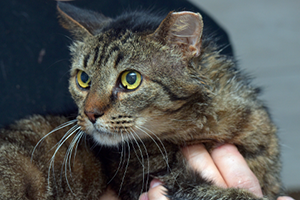Have you noticed a homeless cat in your neighbourhood? Or is a mystery moggy regularly visiting your garden? Find out how to tell if an ownerless cat is stray or feral, and how best to help stray and feral cats.
You may come across what you suppose to be a ‘stray cat’ in your neighbourhood. It isn’t wearing a collar and from talking to your neighbours, you discover that the cat does not appear to be owned by anyone locally. The cat you’ve seen may indeed be a stray that has somehow become separated from its owner. On the other hand, it may be feral.
Understanding the difference between stray and feral cats can help you to work out the best way to interact with an ownerless cat and decide the kindest course of action for its wellbeing.
Between the ages of two and seven weeks, kittens have a crucial developmental window known as the ‘socialisation period’ when they can become used to humans. If they experience positive human contact during this time, they learn to bond with humans and enjoy being household pets. If they don’t, then the chances are they will struggle to successfully live with people.
How to know if a cat is stray
A stray is a cat that has experienced being socialised as a domestic pet, but has become lost or left their home for some reason.
Although a stray cat may initially appear anxious and frightened around people, these animals can successfully be rescued and rehabilitated as pets in a suitable home environment. With encouragement and patience, a stray cat can often reacclimatise to domestic surroundings and human company.
If a stray has been deprived of human interaction for a long time, however, they can sometimes struggle to adapt back to life as a domestic pet. And if a female stray has kittens that grow up without human contact, they will be feral, both as kittens and as adults.
How to tell if a cat is feral
You might be wondering, what does ‘feral’ mean? In its broadest sense, a feral animal is one from a domesticated species that has reverted to living as a wild animal.
A feral cat is a domestic cat that has had no positive human interaction during the socialisation period, and is fearful of humans. They have usually never lived with people. Typically born from stray or other feral cats, they are accustomed to surviving in the great outdoors. If approached, feral cats may cower and flee, or become aggressive and try to attack should they be cornered.
Experts advise against adopting feral cats as domestic pets, since they are not likely to adapt to living indoors and having food provided for them. Nevertheless, kittens born to feral cats can be introduced to humans and socialised from within the socialisation period. Therefore, they can be adopted into domestic homes.
Feral cats shouldn't be confused with wildcats. The Scottish wildcat (or European wildcat) may look a lot like a domestic moggy, but is a distinct species that has never been domesticated.
What’s the difference between stray and feral cats?
Stray cats who are inexperienced at finding shelter and hunting for food tend to look skinny and unkempt if they haven’t found someone to feed them. Despite having lost their owner, they may still be drawn to human company and environments.
In contrast, feral cats tend to be expert hunters and are used to looking after themselves, so they often appear well-fed and groomed. Males tend to be muscular and may have scars from fights with rival cats. They tend to steer clear of humans.
Here are some common physical and behavioural differences to help you know if a cat is stray or feral:
Stray Cat
- Likely to look dirty
- Dishevelled coat
- Skinny body
- Probably lives alone
- May be friendly towards people
- Positive body language – tail up, makes eye contact, may want petting
- Meows or purrs around humans
- Could be microchipped
Feral Cat
- Usually clean, more so if neutered
- Appears generally well-groomed
- Muscular body; may appear well-fed
- Can live alone or as part of a colony of feral cats
- Fearful or aggressive around people
- Negative body language – tail down, avoids eye contact
- Silent around humans
- Not microchipped
- May have their ear tipped, to show they have been neutered and returned to the site
How to help a stray cat
If you’ve found a cat that seems to be a stray, approach cautiously and speak gently. If the cat appears injured or unwell, pick them up carefully, wrap them in a towel and take them to a vet or rescue centre. If the cat seems hurt or in danger, but won’t let you approach, the RSPCA may be able to help.
Petplan has created a guide, with the help of animal welfare charity Blue Cross, which provides advice on helping a stray cat.
Never adopt or rehome an apparent stray without first making every effort to find its owner. Any vet or rescue centre will be able to tell you if the cat has a microchip with the owner’s details. They may also know of local cats that have been reported missing. You could also try using posters, newspaper ads, social media posts or a service such as Pets Located to reunite the cat with its owner. Another option is to put a paper collar, which includes your contact details, on the cat. That way, if the cat does return to their owner, the owner can contact you to let you know the cat isn’t actually a stray.
How to help a feral cat
A healthy feral cat will generally be content living outside and able to look after itself, so the best advice is to leave well alone.
Some animal charities, such as Cats Protection, run Trap, Neuter, Return (TNR) programmes to stop feral cats producing unwanted litters of kittens. This helps the feral cats to be healthier and prevents them becoming a potential nuisance for local residents. TNR involves humanely trapping the cats, neutering them and, while they’re under anaesthetic, removing the tips of the cats’ left ears so they can be easily identified as neutered and don’t get retrapped and put under an unnecessary repeat anaesthetic. TNR is considered the most humane and efficient way of dealing with feral cat populations.


Do you think we’re doing a good job? If you do, please vote for us in this year’s Insurance Choice Awards. Plus, you’ll also be entered into a prize draw to win £1,000 (Ts&Cs apply)
